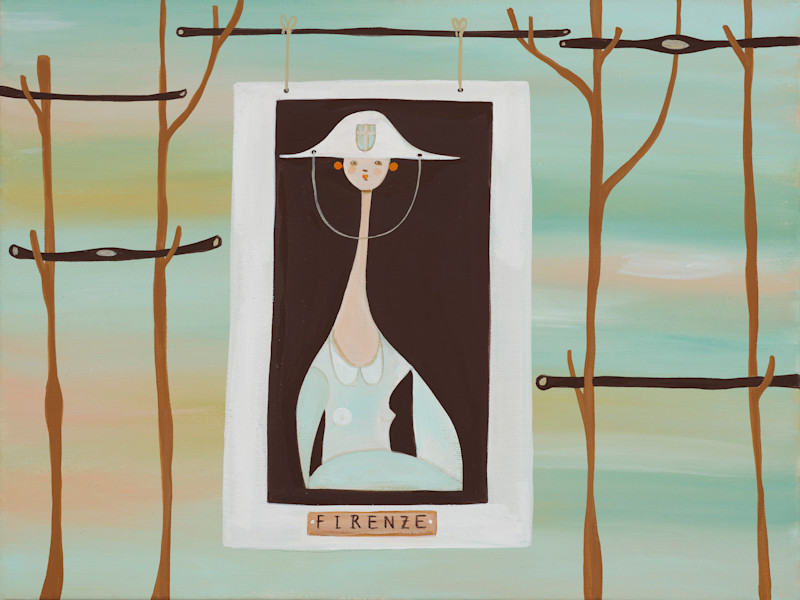About
Liselotte Watkins
La Gita
The oeuvre of Liselotte Watkins can be thought of as a lifelong exploration of the world of shapes and colours. This expedition has carried Watkins and her distinctive and characteristic figures and colour schemes all over the world. After studies in Texas at the Art Institute of Dallas, her career picked up momentum when she moved to New York at the close of the 1990s. There, Watkins soon made an impact with her sophisticated fashion illustrations, which she created for clients like Prada, Vogue, Elle, and The New Yorker.
After living in Milan and Paris, Watkins settled in Rome, where she ended her lauded career as a fashion illustrator in order to focus exclusively on her own art. Her time in Italy has lasted for a little over a decade now, the five most recent years of which she has dedicated entirely to studio painting. During the pandemic lockdown in Italy, Watkins noticed how the women in her neighbourhood spent their time in and around their homes. These observations gave rise to questions and musings: what are these women doing, what are they thinking of, and what do they dream about? Questions and musings led, in turn, to paintings that have won high praise.
As Watkins returns to CFHILL, the venue for her first solo exhibition, Portraits, in 2016, for the fourth time, she is accompanied mainly by old masters. A certain change or progress is evident from the reduced palette she has adopted (this process began back in Rome during lockdown). In this exhibition, La Gita (trip/excursion), Watkins’s artistic explorations have made a stop in Tuscany. There, she has produced several new works that can be viewed as different sections of a story about allegorical characters who lend themselves to each viewer’s particular interpretations.
Although Watkins, during her time in Rome, used to spend a lot of time in environments defined by the geniuses of the Italian baroque, like Bernini and Caravaggio, she has stated that while working on La Gita, she looked rather to Spanish painters such as Francisco de Zurbarán (specifically, his paintings of female saints) and Diego Velázquez. For instance, a work like Frassi reveals obvious inspirations taken from Velázquez’s famous masterpiece Las Meninas. The depicted women (which resemble the figures in 16th century Flemish and Northern European painting) are also characterised by a body language without any of the dramatic expressions of the Baroque, which makes them seem more connected to late medieval painting or the ideals of the early Renaissance.
Art historical references and influences, however, are by no means limited to the works of the old masters. An astute viewer will find numerous playful insertions – references to 20th century masters as well as more general phenomena from contemporary popular culture. A representative and compelling encounter is enacted in the canvas Eva, in which the wall in the background features framed pictures, including one by Picasso and another, seemingly older composition that brings to mind masters from north of the Alps, such as Dürer and Cranach. This approach is reminiscent of that taken by David Hockney in Looking at Pictures on a Screen (1977), in which the model (Henry Geldzahler) poses in front of a screen bearing reproductions of Vermeer, Piero della Francesca, van Gogh, and Degas. As the gaze descends through Watkins’s composition, the eye is caught by a paperback with a blue cut-out by Matisse on its cover. Just behind it, on the same table, we also see a can of Coca-Cola, a distinctly modern temporal marker (as well as a pop culture reference that also associates to the likes of Andy Warhol). Picasso is actually featured on several of these canvases, including Merenda and Matador. The most artful of these references to Picasso is probably the T-shirt in La Famiglia, which is adorned with a reproduction of a famous photo in which Picasso poses in a cowboy outfit.
The new works in La Gita make it very clear that Watkins’s artistic explorations are still, and always, ongoing. At the same time, these paintings are rife with humorous, playful details, which serve to connect these subjects with Watkins’s past studio productions, while also extending a hand to past generations of masters.
Michael Storåkers
Michael Elmenbeck
Anna-Karin Pusic





































